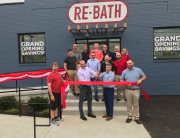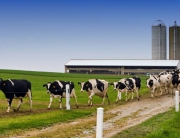Article featured on LancasterOnline.
Dan and Lori Martin raise 600 head of beef cattle on their West Cocalico Township farm. They are also partners in two dairy farms of 110 cows each.
“The dairy operation has been a little tight,” Dan Martin says.
Four years ago, in an effort to diversify, the Martins expanded their farming operation once again — this time with poultry.
As growers for Bell & Evans in Fredericksburg, the Martins care for about 36,000 broilers at a time in a 63-by-500-foot poultry house on their property along Route 897.
The poultry business has been good. So good, in fact, that the Martins are in the process of doubling their operation with a second poultry house.
They are not alone.
“There’s quite a few in the area just recently,” Martin says, noting that his brother and several neighbors have all added poultry houses to their farms, some of them growing for Bell & Evans and others for Perdue.
What the Martins see in their corner of West Cocalico Township is indicative of a countywide trend.
“It’s been a steady flow of new loan requests geared toward the poultry industry, especially compared to other segments of production agriculture, which have been either flat or declining,” says Lyle Hosler, vice president and director of finance for the Economic Development Company of Lancaster County.
Through its financial arm, EDC Finance Corp., the nonprofit EDC arranges loans for small business expansion in the county.
Since 2006, EDC Finance has approved 53 economic development loans for Lancaster County poultry production projects, Hosler says.
“Interestingly, 22 of those projects (42 percent) have come in just the past three years,” he says, “so our numbers definitely show a growing trend for investment since 2015.”
Poultry farming not only includes growing broilers, like the Martins do, but also turkeys and laying hens for egg production. Lancaster County has between 10 million and 12 million laying hens alone, says Greg Martin, an extension educator in poultry with the Penn State Extension. “That’s more than there are people, when you think about it,” he says.
Why the growth in poultry? There are a number of reasons.
For one, while the dairy industry has been struggling, poultry and egg consumption are on the rise.
Sauder’s Eggs has partnered with an increasing number of small farms over the past three years to meet the growing demand for eggs, in particular cage free, free range and organic, says Mark Sauder, president and CEO of the Lititz-based egg wholesaler.
“The value-added side of the business has seen demand growth and that really ties into the good press that eggs have received in the past few years in terms of health benefits,” Sauder says.
A growing change in egg production methods, from conventional caged production to cage-free and alternative housing systems, also requires a greater number of smaller-scale farming operations, he says.
The industry is also benefiting from the sheer growth in the types of products offered, Greg Martin says. Grocery stores carry everything from marinated chicken wings to deviled egg kits. And fast food restaurants that once focused on burgers now have a plethora of chicken offerings, too, he says.
For farmers like the Martins who are looking to diversify, poultry is often a good option because it doesn’t typically take up a lot of space and fits in well with existing operations, Greg Martin says.
“A farm can have beef cattle and poultry, poultry and dairy, swine and poultry,” he says.
The size of the birds also makes them easier to handle, he says. In fact, Dan and Lori Martin say one reason they added poultry was because it offered a nice opportunity for the younger of their seven children to get involved with farming.
Another benefit for poultry producers is Lancaster County’s location and the fact that it is home to allied industries that support poultry production, Greg Martin says.
“If you were trying to build a house, you would need to have a lumber yard to help supply you with what you need. The closer that lumber yard is to your house, the more affordable your house would be,” he says. “All the inputs we would need for a poultry farm, as well as the outputs, the markets, are both present here in the commonwealth.”
Lancaster County has four contractors that build poultry housing. It is also the world headquarters of the poultry watering equipment company Val-Co. Add to that the expertise of the Penn State Extension and proximity to markets on the Eastern seaboard.
“The materials are there,” Martin says.
That doesn’t mean poultry farming is an inexpensive venture.
“Total project costs can range from $750,000 to over $1 million,” Hosler says. “It sort of depends on how many houses they’re putting up.
“Our maximum loan amount cannot exceed $400,000. It typically has a fixed rate for up to 15 years. Interest rates can range from 2 to 3 percent.”
But as long as there’s demand, it’s worth the investment.
And the demand is certainly there, even for beef-loving cattle farmers like Dan Martin, who raves about the quality of the Bell & Evans chickens he grows.
“We eat more chicken now than beef,” he says.







Recent Comments